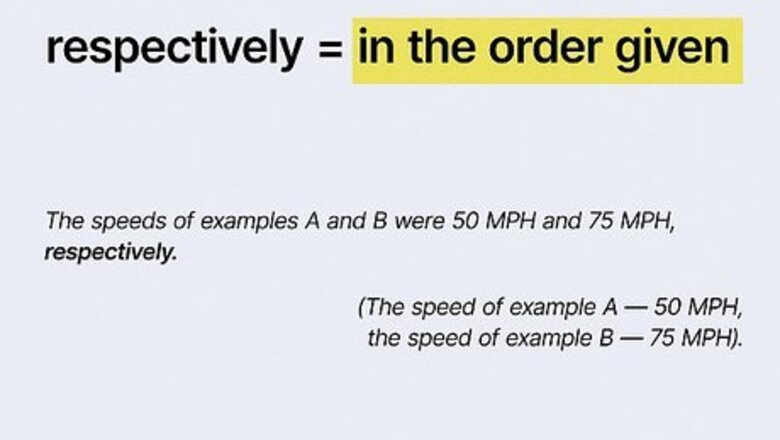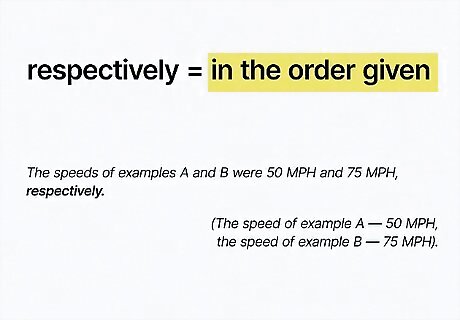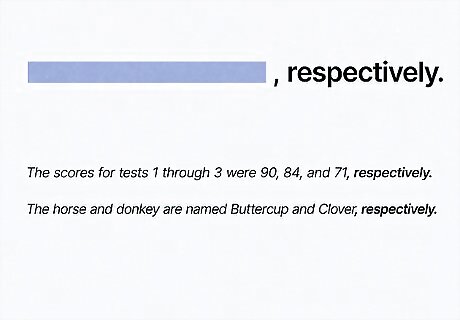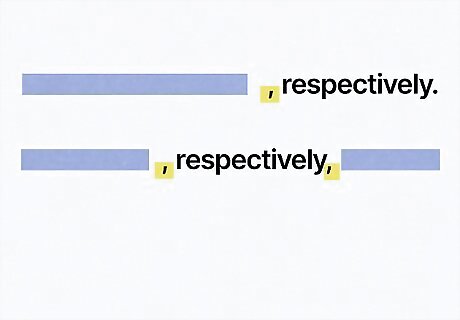
views
- Use the adverb “respectively” at the end of a sentence to explain parallels of an ordered list.
- Place “respectively” in the middle of a sentence between 2 independent clauses to describe corresponding lists.
- Always put a comma before “respectively” if it’s at the end of a sentence, or place commas before and after the word if it’s in the middle of a sentence.
What does “respectively” mean?

“Respectively” relates 2 or 3 items to something previously mentioned. In other words, this adverb means “in the order given.” People often use “respectively” in scientific or mathematical writing when comparing numbers or data. Basically, if you’re listing at least 2 items in a sentence, place “respectively” at the end or middle of a sentence to explain a correspondence or relationship. For instance, say you have the sentence, “The speeds of examples A and B were 50 MPH and 75 MPH, respectively.” In this example, “respectively” explains which speed corresponds with which example: example A went 50 MPH, while example B went 75 MPH.
Using “Respectively” in Your Writing

Use “respectively” at the end of an ordered list. If you’re listing a series of results or items with corresponding or comparable information, place “respectively” at the end of the sentence following a comma. This clarifies to readers which items refer to each other. For example, the sentence “The scores for tests 1 through 3 were 90, 84, and 71, respectively” means that the score for test 1 was 90, the score for test 2 was 84, and the score for test 3 was 71. Another example would be, “The horse and donkey are named Buttercup and Clover, respectively.” The use of “respectively” tells us that the horse’s name is Buttercup and the donkey’s is Clover.
Put “respectively” in the middle of a compound sentence. Say you have a sentence with an ordered list followed by a coordinating conjunction and another phrase or clause. In this instance, “respectively” can be sandwiched between clauses with a comma on either side to show what list items correspond with each other. Let’s return to our horse and donkey example. Maybe you add to the sentence to explain where the animals live: “The horse and donkey are named Buttercup and Clover, and they live in the barn next door.” Adding “respectively” in the middle of this sentence helps readers understand which animal is named what: “The horse and donkey are named Buttercup and Clover, respectively, and they live in the barn next door.” A clause is a complete thought or sentence that has a subject and verb. A compound sentence is a sentence that has two independent clauses that could be sentences on their own. A coordinating conjunction is a word that combines 2 like clauses, such as for, and, nor, but, or, yet, or so. Use the acronym FANBOYS to remember this grammar rule.
Do you put a comma before “respectively”?

Yes, always place a comma before “respectively” in a sentence. Whether you’re putting this adverb at the end or middle of a sentence, use commas to make your sentence grammatically correct. Check out these examples on how to use a comma with “respectively”: Place a comma before “respectively” if you’re explaining a list in a simple sentence with one independent clause. Amy and her sister are 18 and 22, respectively. The profits in June and July grew 15% and 30%, respectively. Use commas before and after “respectively” when it's in the middle of a sentence. In this context, “respectively” is acting as an adverbial appositive. Amy and her sister are 18 and 22, respectively, and they love spending time together. The profits in June and July grew 15% and 30%, respectively, but the company still experienced losses. An appositive is a word or phrase that explains the term before it, and commas separate the additional clause from the main thought.
















Comments
0 comment